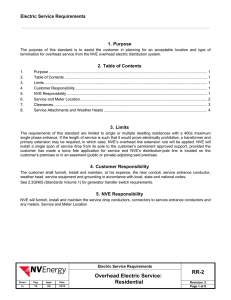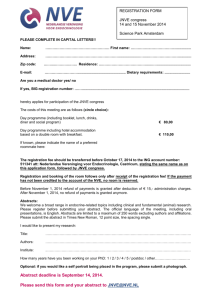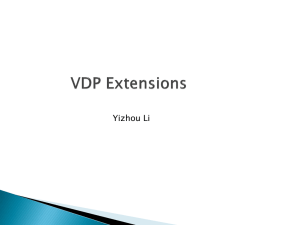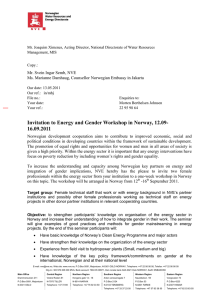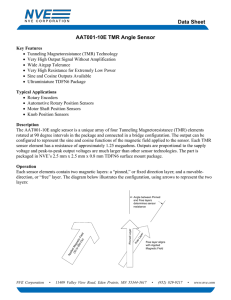NV Energy OVERHEAD ELECTRIC RESIDENTIAL SERVICE
advertisement
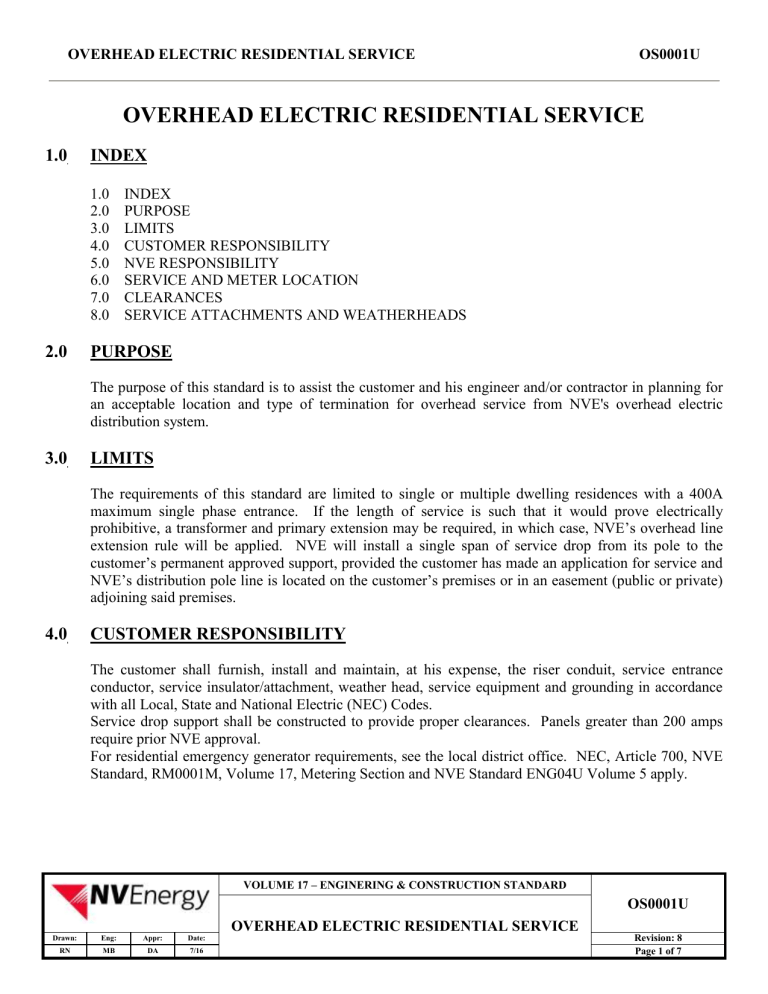
OVERHEAD ELECTRIC RESIDENTIAL SERVICE OS0001U OVERHEAD ELECTRIC RESIDENTIAL SERVICE 1.0 INDEX 1.0 2.0 3.0 4.0 5.0 6.0 7.0 8.0 2.0 INDEX PURPOSE LIMITS CUSTOMER RESPONSIBILITY NVE RESPONSIBILITY SERVICE AND METER LOCATION CLEARANCES SERVICE ATTACHMENTS AND WEATHERHEADS PURPOSE The purpose of this standard is to assist the customer and his engineer and/or contractor in planning for an acceptable location and type of termination for overhead service from NVE's overhead electric distribution system. 3.0 LIMITS The requirements of this standard are limited to single or multiple dwelling residences with a 400A maximum single phase entrance. If the length of service is such that it would prove electrically prohibitive, a transformer and primary extension may be required, in which case, NVE’s overhead line extension rule will be applied. NVE will install a single span of service drop from its pole to the customer’s permanent approved support, provided the customer has made an application for service and NVE’s distribution pole line is located on the customer’s premises or in an easement (public or private) adjoining said premises. 4.0 CUSTOMER RESPONSIBILITY The customer shall furnish, install and maintain, at his expense, the riser conduit, service entrance conductor, service insulator/attachment, weather head, service equipment and grounding in accordance with all Local, State and National Electric (NEC) Codes. Service drop support shall be constructed to provide proper clearances. Panels greater than 200 amps require prior NVE approval. For residential emergency generator requirements, see the local district office. NEC, Article 700, NVE Standard, RM0001M, Volume 17, Metering Section and NVE Standard ENG04U Volume 5 apply. VOLUME 17 – ENGINERING & CONSTRUCTION STANDARD OS0001U OVERHEAD ELECTRIC RESIDENTIAL SERVICE Drawn: Eng: Appr: Date: RN MB DA 7/16 Revision: 8 Page 1 of 7 OVERHEAD ELECTRIC RESIDENTIAL SERVICE 5.0 OS0001U NVE RESPONSIBILITY NVE will furnish, install and maintain the service drop conductors, cable connectors to service entrance conductors and meters. 6.0 SERVICE AND METER LOCATION All service drop locations shall be approved by NVE prior to construction of the service entrance. The location of the point of attachment of the service drop at the building shall be such that it can be reached with a single span of wire from the NVE pole secondary attachment point. A 100 foot limitation applies for a 100 amp panel, 75 foot for a 200 amp panel and 30 feet for a 320 amp panel. (Refer to Vol. 3, GEN02T, Section 11) Heavy snow loading area shall be a maximum of 75 feet for a 100 amp panel. No overhang of adjacent property and proper clearances must be maintained. This point of attachment will normally be on a periscope through the roof or a building wall or facing the nearest NVE line. When it is impractical to attach the service drop below the level of the weather head, the termination shall not consist of more than 3 feet of exposed wire and shall not extend around the corner of the building. See section 8.0 for installation details. Meter facilities shall be located within the first ten feet of structure. The meter location must not be fenced or otherwise obscured from view of meter readers, or impair the access of operations personnel. Where NVE allows the meter facilities to be fenced, the customer shall provide a means for direct access by NVE personnel, (i.e., easily opened, unobstructed gate). VOLUME 17 – ENGINERING & CONSTRUCTION STANDARD OS0001U OVERHEAD ELECTRIC RESIDENTIAL SERVICE Drawn: Eng: Appr: Date: RN MB DA 7/16 Revision: 8 Page 2 of 7 OVERHEAD ELECTRIC RESIDENTIAL SERVICE OS0001U NOTES: 1. 2. If a preferred location is not practicable, consult NVE in regard to an alternate location. All service locations are subject to NVE approval. Installation of additional facilities at the customer’s expense or future relocation at his expense may be prevented by early consultation of NVE. For heavy snow areas, see Section 9.0, in this standard. A 36"x 36" x 78" working space in front of all meters is required to permit installation and provide a safe working environment for NVE personnel. Any exceptions from this requirement must be approved by NVE. The customer for architectural reasons may conceal or recess the service entrance and meter in through the outside wall where permitted by local codes. For detailed clearance requirements, see Section 5.2 of GM0001M, Volume 17, Section 8. For detailed service equipment requirements, see RM0001M, Electric Metering Residential, Volume 17, Section 8. 3. 4. 5. 6. 7.0 CLEARANCES The minimum acceptable clearances for overhead service drops are outlined in National Electric Safety Code / NDOT requirements. Upon request, your NVE representative will specify a point of attachment which will provide the required clearance of the service wires above thoroughfares and structures and from windows, doors, and exits of buildings. VOLUME 17 – ENGINERING & CONSTRUCTION STANDARD OS0001U OVERHEAD ELECTRIC RESIDENTIAL SERVICE Drawn: Eng: Appr: Date: RN MB DA 7/16 Revision: 8 Page 3 of 7 OVERHEAD ELECTRIC RESIDENTIAL SERVICE 8.0 OS0001U SERVICE ATTACHMENTS AND WEATHER HEADS Two types of service attachments are used by NVE, service insulators attached to the building and periscopes which extend above the roof. The periscope attachment is the preferred method. Typical methods of attaching residential overhead service are illustrated in this section. Where the building is high enough to permit proper clearance, the service insulator can be located on roof rafters or wall studs. Customer will provide backing for the service insulator (min. 2" x 4"), securely anchored to building frame. Service insulator will not be attached to roof fascia or wall sheeting unless proper backing is provided. Customer to provide and install the service insulator and attachments. Screw type insulators are not approved. VOLUME 17 – ENGINERING & CONSTRUCTION STANDARD OS0001U OVERHEAD ELECTRIC RESIDENTIAL SERVICE Drawn: Eng: Appr: Date: RN MB DA 7/16 Revision: 8 Page 4 of 7 OVERHEAD ELECTRIC RESIDENTIAL SERVICE OS0001U A periscope attachment is the preferred method by providing a better support for the service wire, and better clearance of conductors. Periscopes are to be a minimum of 2" rigid steel securely fastened to the building stud. Periscopes are to extend a minimum of 26" above the roof. NOTES: 1. Periscopes are to be installed per NEC, Article #230. Periscope structures projecting over 30" above the roof must be braced against the normal pull of the service drop conductors (see Section 4.0). Bracing will be required for larger conductors or longer spans. Bracing, when required, shall consist of two galvanized steel members installed at approximately 90° spread. Minimum size brace shall be 1¼" x 1¼" x 1/8" galvanized steel angle. Periscope bracing shall be anchored through the sub-roof with a minimum of 3/8" galvanized carriage bolts. For snow loading areas see Page 6. Riser conduit will not have couplings above the roof or accessible points from the top of the meter panel to the weather head (J-boxes, LB’s LR’s LL’s). Service weather heads shall not be located on the exterior face of any wall which is less than 2' from any common property line. Point of attachment of service drop must be high enough to meet required clearance. (See Page 3, Section 7.0 for clearance details). Alternate service attachment points must not be more than 24" from weather head. Service conductors must extend a minimum of 18" from weather head to provide for the make-up of the required drip loop. The conductor service insulator and attachment will be provided and installed by the customer. Screw type insulators are not approved. All overhead and underground feed NVE meter service panels (meter sockets), panel boards or service riser piping cannot be installed within 36 inches (minimum) of any windows, man doors, vents, garage doors, water irrigation valves or gas regulators. 2. 3. 4. 5. 6. 7. VOLUME 17 – ENGINERING & CONSTRUCTION STANDARD OS0001U OVERHEAD ELECTRIC RESIDENTIAL SERVICE Drawn: Eng: Appr: Date: RN MB DA 7/16 Revision: 8 Page 5 of 7 OVERHEAD ELECTRIC RESIDENTIAL SERVICE 9.0 OS0001U SPECIAL SERVICE REQUIREMENTS FOR HEAVY SNOW LOADING AREAS In areas of heavy snow loading the customer shall locate the service entrance in such a manner so that storm damage will be kept to a minimum. Heavy snow areas are defined in general as areas above 6,000 feet elevation. Check with local NVE office for snow loading requirements. a. Span length of service drop to be a maximum of 75 feet (#2 triplex). Larger conductor will require shorter length. b. Weatherhead should be located on the garage side of the structure and as high as practical to keep clear of snow. c. Service drop will be attached at house gable (preferred location) to protect services from snow sliding off the roof. d. Meter equipment is to be located on gable side of house within3' of a snow plowed area. e. Periscope service entrance per NEC, Article #230 and must be approved by NVE prior to installation. f. Snow splitters are required to be provided and installed by the customer (roofing contractor). Snow splitters must protect the periscope, weather head and any associated bracing. Snow splitters may be purchased though a local sheet metal shop. Please provide the shop with the slope of your roof and the information included under note 1 of the next page. See details next page. g. New services will NOT be attached to trees. h. Screw-type insulators will not be allowed for new services. All new services attached to the house will be a 40-S insulator bolted to a reinforced location as determined by NVE, see Section 8.0. VOLUME 17 – ENGINERING & CONSTRUCTION STANDARD OS0001U OVERHEAD ELECTRIC RESIDENTIAL SERVICE Drawn: Eng: Appr: Date: RN MB DA 7/16 Revision: 8 Page 6 of 7 OVERHEAD ELECTRIC RESIDENTIAL SERVICE OS0001U NOTES: 1. Snow splitters must completely cover the periscope and bracing to protect it. 1) Minimum 10" wide at the base. 2) Minimum 20 gauge sheet metal. 3) 4" flange, rolled edge, for roof attachment without shingles. 4) ¾- 1" flange for roof attachment with shingles. 5) 4" max. on center attachment points along flange for roof attachment. 6) Height to match height of weather head. Periscope to be installed per NEC, Article #230. If periscope extends over 30" (less than 30" is preferred) above roof, a minimum 2" galvanized steel riser pipe, braced with 1½" x 1½" x 3/16" galvanized angle iron, anchored through the sub-roof with 1/2" minimum galvanized bolts is required. All other requirements of Sections 7.0 and 8.0 are applicable. 2. 3. VOLUME 17 – ENGINERING & CONSTRUCTION STANDARD OS0001U OVERHEAD ELECTRIC RESIDENTIAL SERVICE Drawn: Eng: Appr: Date: RN MB DA 7/16 Revision: 8 Page 7 of 7
